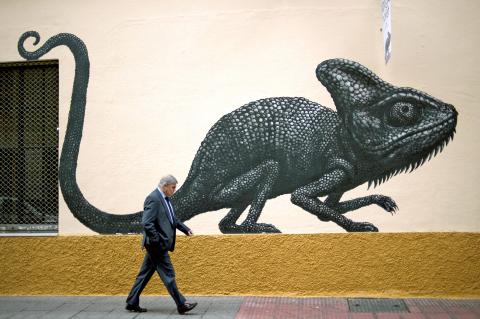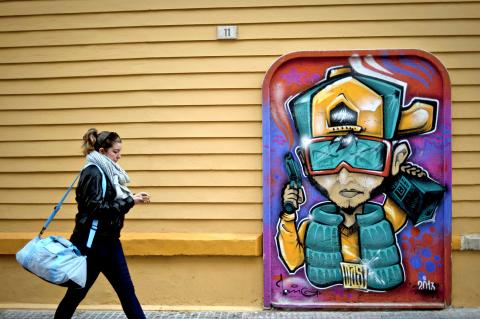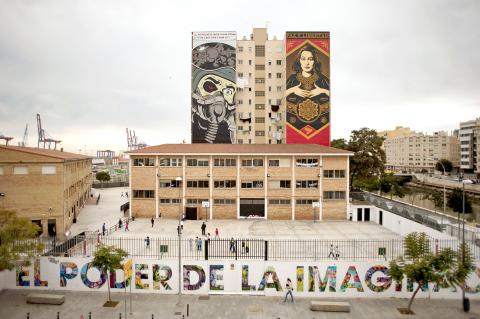When the Spanish city of Malaga wanted to clean up its sleazy port side district, it called in the painters — big international names in the street art movement.
In streets formerly roamed by sex workers and drug dealers, the faded 19th-century buildings now bear weird and wonderful murals by street artists from the UK, US and beyond.
Far from covert acts of tagging, the works were ordered by local authorities tapping in to a once-renegade art movement that has now become respectable.

Photo: AFP/Jorge Guerrero
Along with newly pedestrianized streets, spruced-up parks and new streetlights, they have revived the Heredia district near the Guadalmedina river. It has now been dubbed “Soho,” after arty districts in New York and London.
“The idea originally came from the locals and a few businesses,” said Fernando Frances, director of the city’s Contemporary Art Center and one of the organizers.
“We thought street art would contribute to giving the cultural image that we wanted.”

Photo: AFP/Jorge Guerrero
Among the street stars recruited was US artist Shepard Fairey — known for a stylized portrait of Barack Obama, titled Hope, and the iconic Obey face logo.
A vast Fairey mural portrait of a woman with the slogan “Peace and Liberty” adorns one side of a 10-floor building at an entrance point to the district.
Opposite soars a design by UK street artist D*Face, a giant close-up face-shot of a deranged fighter pilot.

Photo: AFP/Jorge Guerrero
STREET TO THE NET
Traditionally a secretive genre ranging from graffiti to stickers, stencils and cunning visual illusions, street art boomed in the 1980s and has since gone mainstream. Some of Fairey’s works, for example, have been bought by museums.
But Frances said it was not always easy to track down the artists, many of whom still work anonymously and without authorization.
He managed to get hold of about 50 artists, however, and gave them free rein to brighten up the district’s public walls and shopfronts.
Among them was Dadi Dreucol, a 26-year-old local Spanish artist, who painted bizarre murals of black masked figures.
Dreucol has been painting since he was 12 but says the scene has taken off lately thanks to the internet.
“Before, you had to go where the paintings were” to see them, he said.
“Now you paint in the street, someone takes a photo and a second later it’s been sent and people can see it in Japan.”
Taking part in the project in his home city brought his work to the attention of a German gallery, which has granted him a three-month work placement.
WAITING FOR SHOPPERS
The street art has also improved life for some of Malaga’s other 568,000 inhabitants.
Antonio Mancera, 63, smiles proudly at the scaly chameleon design on the wall of his house by the Belgian artist Roa. He offers to show visitors around the district’s various murals.
“There was a desire to revive this neighborhood,” he said.
Locals hoped the murals would lure tourists who generally shun the Malaga waterfront in favor of beaches further along the coast.
Now the street art has landed, some are trickling by.
“It is often their children who find out there is a street art scene” and take their parents to see it, said one local artist, Javier Calleja.
Authorities have held concerts and exhibitions, encouraging shops and art galleries to set up in the district.
Pedro Marin Cots, top town-planning official in city hall, said 34 businesses have been opened or renovated in the area since the project launched in July 2013.
Among them is a bicycle shop set up by Javier Marin, a 27-year-old with a hipster beard and horn-rimmed glasses.
Eight months after opening, however, he said shoppers are not yet flocking to the district. He is hoping for an increase in business come summer.
The city has issued a call for a second round of street art contributors.
“There’s a lot still to do before this will be a Soho like in the big cities,” Marin said.

Behind a car repair business on a nondescript Thai street are the cherished pets of a rising TikTok animal influencer: two lions and a 200-kilogram lion-tiger hybrid called “Big George.” Lion ownership is legal in Thailand, and Tharnuwarht Plengkemratch is an enthusiastic advocate, posting updates on his feline companions to nearly three million followers. “They’re playful and affectionate, just like dogs or cats,” he said from inside their cage complex at his home in the northern city of Chiang Mai. Thailand’s captive lion population has exploded in recent years, with nearly 500 registered in zoos, breeding farms, petting cafes and homes. Experts warn the

The unexpected collapse of the recall campaigns is being viewed through many lenses, most of them skewed and self-absorbed. The international media unsurprisingly focuses on what they perceive as the message that Taiwanese voters were sending in the failure of the mass recall, especially to China, the US and to friendly Western nations. This made some sense prior to early last month. One of the main arguments used by recall campaigners for recalling Chinese Nationalist Party (KMT) lawmakers was that they were too pro-China, and by extension not to be trusted with defending the nation. Also by extension, that argument could be

Aug. 4 to Aug. 10 When Coca-Cola finally pushed its way into Taiwan’s market in 1968, it allegedly vowed to wipe out its major domestic rival Hey Song within five years. But Hey Song, which began as a manual operation in a family cow shed in 1925, had proven its resilience, surviving numerous setbacks — including the loss of autonomy and nearly all its assets due to the Japanese colonial government’s wartime economic policy. By the 1960s, Hey Song had risen to the top of Taiwan’s beverage industry. This success was driven not only by president Chang Wen-chi’s

Last week, on the heels of the recall election that turned out so badly for Taiwan, came the news that US President Donald Trump had blocked the transit of President William Lai (賴清德) through the US on his way to Latin America. A few days later the international media reported that in June a scheduled visit by Minister of National Defense Wellington Koo (顧立雄) for high level meetings was canceled by the US after China’s President Xi Jinping (習近平) asked Trump to curb US engagement with Taiwan during a June phone call. The cancellation of Lai’s transit was a gaudy